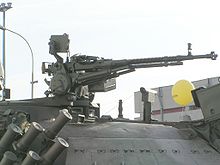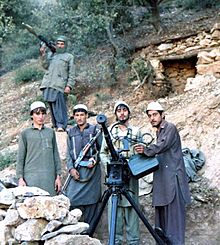- DShK
-
DShK 
DShK on wheeled mount with shield.Type Heavy machine gun Place of origin  Soviet Union
Soviet UnionService history In service 1938 – Present Used by See Users Wars World War II
Korean War
Chinese Civil War
Vietnam War
Cambodian Civil War
Cambodian-Vietnamese War
Six-Day War
Yom Kippur War
Iran-Iraq war
Gulf War
Yugoslav wars
Iraq War
Afghan War
Cambodian–Thai border stand-off
2011 Libyan civil warProduction history Designer Vasily Degtyaryov, Georgi Shpagin Designed 1938 Variants DK, DShKM , DSHKS, Type 54 HMG Specifications Weight 34 kg (74.96 lb) (gun only)
157 kg (346.13 lb) on wheeled mountingLength 1,625 mm (64.0 in) Barrel length 1,070 mm (42.1 in) Cartridge 12.7x108mm Action gas-operated reloading Rate of fire 600 rounds/min Muzzle velocity 850 m/s (2,788 ft/s) Effective range 2000 m Maximum range 2500 m Feed system belt 50 rounds Sights Iron/Optical The DShK 1938 (ДШК, for Дегтярёва-Шпагина Крупнокалиберный, Degtyaryova-Shpagina Krupnokaliberny, 'Degtyaryov-Shpagin Large-Calibre') is a Soviet heavy machine gun firing the 12.7x108mm cartridge. The weapon was also used as a heavy infantry machine gun, in which case it was frequently deployed with a two-wheeled mounting and a single-sheet armour-plate shield. It took its name from the weapons designers Vasily Degtyaryov, who designed the original weapon, and Georgi Shpagin, who improved the cartridge feed mechanism. It is sometimes nicknamed Dushka (lit. "Sweetie", "Dear"), from the abbreviation.
Contents
History
The requirement for a heavy machine gun appeared in 1929. The first such gun, the Degtyaryov, Krupnokalibernyi (DK, Degtyaryov, Large calibre), was built in 1930 and this gun was produced in small quantities from 1933 to 1935.
The gun was fed from a drum magazine of only thirty rounds, and had a poor rate of fire. Shpagin developed a belt feed mechanism to fit to the DK giving rise, in 1938, to the adoption of the gun as the DShK 1938. This became the standard Soviet heavy machine gun in World War II.
Like its U.S. equivalent, the M2 Browning, the DShK 1938 was used in several roles. As an anti-aircraft weapon it was mounted on pintle and tripod mounts, and on a triple mount on the GAZ-AA truck. Late in the war, it was mounted on the cupolas of IS-2 tanks and ISU-152 self-propelled guns. As an infantry heavy support weapon it used a two-wheeled trolley, similar to that developed by Sokolov for the 1910 Maxim gun. It was also mounted in vehicle turrets, for example, in the T-40 light amphibious tank.
In 1946, the DShK 1938/46 or DShKM (M for modernised) version was introduced.
In addition to the Soviet Union and Russia, the DShK has been manufactured under license by a number of countries, including the People's Republic of China, Pakistan and Romania. Today, it has largely been phased out in favour of the more modern NSV and Kord designs.
A British Army Westland Lynx helicopter was hit 15 times and forced to make an emergency landing in June 1988 during The Troubles by two Provisional IRA DShK's smuggeled in from Libya near Cashel Lough Upper, south County Armagh.[1] They were also used in 2004, against British troops in Al-Amarah, Iraq.[2]
Users
 DShKM on a Romanian TR-85 main battle tank
DShKM on a Romanian TR-85 main battle tank
Non-state users
- Iraqi insurgency[2]
- Provisional IRA[7]
- Viet Cong: Extensively used during the Vietnam War.[5]
- Anti-Gaddafi forces: Used along with other heavy automatic weapons mounted on technicals during the 2011 Libyan civil war.[8]
Gallery
-
Albanian DShK probably of Chinese origin - Close Air Defence version.
-
DShK firing at Babadag Training Area, Romania.
See also
External links
- DShK and DShKM at guns.ru.
- Russian 12.7 mm (0.5") DShK Wheeled Heavy Machine Gun – Walk around photos
- Soviet 12.7 mm DShK a/a navy machine gun – Walk around photos
- Soviet 12.7 mm DShK on ZIS-5V truck – Walk around photos
- image
- Video of Operation
References
- ^ Harnden, Toby (2000).Bandit Country:The IRA and South Armagh. Coronet Books, pp. 360-361 ISBN 0340717378
- ^ a b Mills, Dan (2007). "16". Sniper One. Penguin Group. p. 192. ISBN 978-0-718-14994-9. "They were Dshkes, a Russian-made beast of a thing that fires half-inch calibre rounds and was designed to bring down helicopters."
- ^ a b c d e f g h i j k l m n o p q r s t u v w x y z aa ab ac ad ae af ag ah ai aj ak al am an ao ap aq ar as at au av aw ax ay az ba bb bc bd be bf bg bh bi Jones, Richard D.; Ness, Leland S., eds (January 27, 2009). Jane's Infantry Weapons 2009/2010 (35th ed.). Coulsdon: Jane's Information Group. ISBN 9780710628695.
- ^ Gander, Terry J.; Hogg, Ian V. Jane's Infantry Weapons 1995/1996. Jane's Information Group; 21 edition (May 1995). ISBN 978-0710612410.
- ^ a b c d e Miller, David (2001). The Illustrated Directory of 20th Century Guns. London: Salamander Books Ltd.. ISBN 9781840652451.
- ^ a b c http://en.calameo.com/read/000127853fed679f5ecec
- ^ uncovering the irish republican army pbs.org
- ^ Al-Jazeera coverage of Libyan uprising Youtube.com
- Koll, Christian (2009). Soviet Cannon - A Comprehensive Study of Soviet Arms and Ammunition in Calibres 12.7mm to 57mm. Austria: Koll. p. 53. ISBN 978-3-200-01445-9. http://www.russianammo.org.
Soviet infantry weapons of World War IISide-arms Rifles & carbines Submachine guns Grenades Machine guns & other larger weapons M1910 Maxim • DS-39 • DP • SG-43 Goryunov • Maxim-Tokarev • DShK • PTRD • PTRS-41 • PV-1 • ROKS-2/ROKS-3Cartridges used by the USSR during WWII 7.62×25mm Tokarev • 7.62×38mmR • 7.62×54mmR • 12.7×108mm • 14.5×114mm • 7.63×25mm MauserWeapons and military equipment designed or licence-manufactured in IranFirearms PistolsArmour and other
land based vehiclesArtillery HM-40 · HM 41MRLS Recoilless rifles Mortars 37mm Marsh Mortaranti-aircraft guns Anti-tank missiles RPG-7 · Saegheh (rocket) · Type 69 RPG · RPG-29 · RAAD · Saeghe · Toophan · Toophan 2 · Towsan · 9K115-2 Metis-MCategories:- World War II Soviet infantry weapons
- 12.7 mm machine guns
- Machine guns of the Soviet Union
- Korean War infantry weapons
- Weapons of the Vietnam War
Wikimedia Foundation. 2010.





